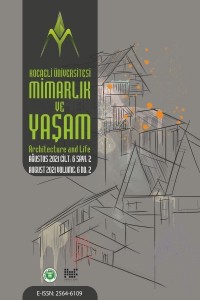Weissenhof ve Kochenhof Stuttgart Yerleşkelerinin Deutscher Werkbund’un Misyonu Özelinde Tarihsellik Bağlamında Okunması
Öz
Weissenhof ve Kochenhof Stuttgart Yerleşkelerinin Deutscher Werknund’un Misyonu Özelinde Tarihsellik Bağlamında Okunması adlı makale, Deutscher Werkbund kuruluşunun kendine biçtiği misyonlar bağlamında bir mimarlık manifestosu olarak güçlü alt metinleriyle birlikte üretilen, Weissenhof yerleşkesinin, onun antitezi olarak sunulan Kochenhof yerleşkesinin de dikkate alınarak okunmasını amaçlar. Mimarlık tarih yazımında ikili karşıtlık nesneleri olarak anlatılagelen bu iki yerleşkenin şifreleri, politik ve sosyal arka planları, ideolojik tandansları ve çoğulluk ya da aynılık barındıran morfolojileri bağlamında çözülmeye çalışılır. Bu sebeple önce Almanya’nın mimarlık üretimini kavramsallaştırarak misyonunu belirleyen Deutscher Werkbund kuruluşunun yapısı incelenir. Söz konusu kuruluşun strüktürü ve aktörleri bağlamında Birinci Dünya Savaşı öncesinden 1920’lerin sonuna kadar uzanan dönemin tasarım manifestolarına dair bilgiler verilir. Ardından önce metnin temelini oluşturan Weissenhof yerleşkesinin ortaya çıkış dinamikleri incelenir. Ardından Kochenhof yerleşkesinin misyoner tandansları yine dönemin aktörleri ve politik eğilimleri bağlamında okunmaya çalışılır. Makale bir yandan içine aldığı dönemde Almanya’nın mimari üretim ve pratiklerini açıklığa kavuşturmaya çalışırken diğer yandan politik ve kültürel arka planına dair önemli bir hikaye ortaya koyan iki yerleşkenin morfolojik ve ideolojik özelliklerini ortaya koyar.
Kaynakça
- Berman, M. (1988). All That Is Solid Melts Into the Air: the Experience of Modernity. New York: Viking Penguin.
- Bonatz, P. (1926). Noch einmal die Werkbundsiedlung. Schwaebische Kronik, 2, 4.
- Giedion, S. (2001). Space, Time & Architecture The Growth of a New Tradition. London: Harvard University Press.
- Kirsch, K. (1997). Briefe zur Weissenhofsiedlung. Stuttgart: Deutsche Verlags-Anstalt.
- Le Corbusier. (2005). Bir Mimarlığa Doğru. İstanbul: Yapı Kredi Yayınları.
- Loos, A. (1998). Ornament and Crime. Ornament and Crime: Selected Essays (pp. 39-55). Riverside: Ariadne Press.
- Maciuika, J. (2009). The Deutscher Werkbund and the Ottoman Empire: Design Reform, Economic Policy and Foreign Policy Before the First World War. Modernleşmenin Tasarımı Türkiye’de Mimarlık, Sanat, Tasarım Eğitimi ve Bauhaus (pp. 67-79). İstanbul: İletişim Yayınları.
- Merzi, S. (2005). Çevirmenin Önsözü, Bir Mimarlığa Doğru (pp. 9-13). İstanbul: Yapı Kredi Yayınları.
- Plarre, S. (2001). Die Kochenhofsiedlung-Das Gegenmodell zur Weissenhofsiedlung. Stuttgart: Hohenheim.
- Schwartz, F. (1996). The Werkbund Design Theory and Mass Culture Before the First World War. London: Yale University Press.
- Ulmer, M., & Kurz, J. (2006). Die Weissenhofsiedlung Geschichte und Gegenwart. Stuttgart: Hampp Verlag.
- Wikipedia. (2021). Peter Behrens. Retrieved from https://www.google.com/search?q=peter+behrens+aeg&client=safari&rls=en&source=lnms&tbm=isch&sa=X&ved=2ahUKEwiTuqfiv9LwAhUS-aQKHUsmAa8Q_AUoAXoECAEQAw&biw=1564&bih=1333 Erişim tarihi: 10.03.2021, 15.00.
A Historical Reading on Weissenhof and Kochenhof Settlements on Behalf of Deutscher Werkbund’s Mission
Öz
The article titled A Historical Reading on Weissenhof and Kochenhof Settlements on Behalf of Deutscher Werkbund’s Mission aims to read the Weissenhof settlement, which is presented as an architectural manifesto in the context of the missions that Deutscher Werkbund has set itself wiyhin the context of a dichotomy defined by the Kochenhof settlement. The codes of these two settlements, which have been described as objects of binary opposition in architectural historiography, are tried to be resolved in the context of their political and social backgrounds, ideological conventions, and morphologies that include plurality or sameness. For this reason, the structure of the Deutscher Werkbund foundation, which determines its mission by conceptualizing Germany's architectural production, is examined first. In the context of the structure and actors of the organization in question, information is given on the design manifestos of the period from before the First World War to the end of the 1920s. Then, the emergence dynamics of the Weissenhof settlement, which forms the basis of the text, are analyzed first. Then, the missionary fantasies of the Kochenhof campus are tried to be read in the context of the actors and political tendencies of the period. The article tries to clarify the architectural production and practices of Germany in the period it covers, on the other hand, it reveals the morphological and ideological characteristics of the two dettlements that reveal an important story about their political and cultural background.
Anahtar Kelimeler
Kaynakça
- Berman, M. (1988). All That Is Solid Melts Into the Air: the Experience of Modernity. New York: Viking Penguin.
- Bonatz, P. (1926). Noch einmal die Werkbundsiedlung. Schwaebische Kronik, 2, 4.
- Giedion, S. (2001). Space, Time & Architecture The Growth of a New Tradition. London: Harvard University Press.
- Kirsch, K. (1997). Briefe zur Weissenhofsiedlung. Stuttgart: Deutsche Verlags-Anstalt.
- Le Corbusier. (2005). Bir Mimarlığa Doğru. İstanbul: Yapı Kredi Yayınları.
- Loos, A. (1998). Ornament and Crime. Ornament and Crime: Selected Essays (pp. 39-55). Riverside: Ariadne Press.
- Maciuika, J. (2009). The Deutscher Werkbund and the Ottoman Empire: Design Reform, Economic Policy and Foreign Policy Before the First World War. Modernleşmenin Tasarımı Türkiye’de Mimarlık, Sanat, Tasarım Eğitimi ve Bauhaus (pp. 67-79). İstanbul: İletişim Yayınları.
- Merzi, S. (2005). Çevirmenin Önsözü, Bir Mimarlığa Doğru (pp. 9-13). İstanbul: Yapı Kredi Yayınları.
- Plarre, S. (2001). Die Kochenhofsiedlung-Das Gegenmodell zur Weissenhofsiedlung. Stuttgart: Hohenheim.
- Schwartz, F. (1996). The Werkbund Design Theory and Mass Culture Before the First World War. London: Yale University Press.
- Ulmer, M., & Kurz, J. (2006). Die Weissenhofsiedlung Geschichte und Gegenwart. Stuttgart: Hampp Verlag.
- Wikipedia. (2021). Peter Behrens. Retrieved from https://www.google.com/search?q=peter+behrens+aeg&client=safari&rls=en&source=lnms&tbm=isch&sa=X&ved=2ahUKEwiTuqfiv9LwAhUS-aQKHUsmAa8Q_AUoAXoECAEQAw&biw=1564&bih=1333 Erişim tarihi: 10.03.2021, 15.00.
Ayrıntılar
| Birincil Dil | Türkçe |
|---|---|
| Konular | Mimarlık |
| Bölüm | Makaleler |
| Yazarlar | |
| Yayımlanma Tarihi | 31 Ağustos 2021 |
| Yayımlandığı Sayı | Yıl 2021 Cilt: 6 Sayı: 2 |

